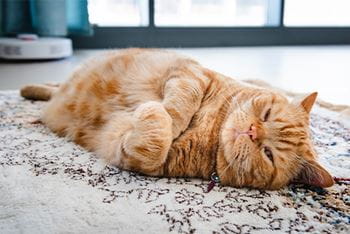
Did you know that half of all domestic pets are considered overweight or obese? This is a growing concern that can lead to a variety of health issues, such as diabetes, joint problems and heart disease. Recognizing and addressing obesity in pets will improve their overall well-being and provide them with the best opportunity for a long and healthy life.
Preventing obesity in pets starts with understanding your pet’s nutritional needs. Different lifestages and breeds have varying dietary requirements. A proper diet is essential for maintaining a healthy weight and preventing obesity.
One common cause of pet obesity is overfeeding. Pet food packaging offers feeding guidelines, but often it’s too much for mildly active or inactive pets. Additionally, many pet owners inadvertently overmeasure portions. It's vital to count calories or carefully measure food to prevent your pet from becoming overweight or obese.
Ask your veterinarian to help you choose the best diet for your pet, as well as accurate portions. Depending on your pet’s stage of life, they have different nutritional needs. The right diet can go a long way to keep your pet at their ideal weight.
For overweight pets, a structured feeding schedule is key. Feed your pet two or three times per day at scheduled feeding times. Avoid letting your pet graze all day long. Ensure only one person is responsible for feeding your pet to avoid accidental overfeeding. Pets are great at begging and may deceive multiple family members into feeding them, leading to overeating.
Reducing treats is also important to reduce your pet’s weight. Just four or five treats can easily equal an extra meal’s worth of calories. Treats should account for no more than 5-10% of your pet’s daily calories.
It’s vital to count calories or carefully measure the food when reducing your pet’s weight. Overfeeding leads to no weight loss, while underfeeding can cause serious health issues related to malnutrition.
Interactive feeding toys, like puzzle feeders or feeding mats, are excellent tools to help your pet work for their food. These toys not only help expend more calories but also slow down your pet’s eating.
Increasing your pet’s exercise is an effective way to help them lose weight, but always consult with your veterinarian before starting any high-intensity activities.
For cats, increase their activity level by teaching them to walk on a leash, and use interactive toys like laser pointers and feather wands. Consider a cat tree or cat condo with various heights to encourage more movement.
For dogs, extend outdoor time by walking, swimming, playing fetch or going for a run. Consistent physical activity is essential for burning calories and keeping your dog fit.
Training sessions can also be beneficial for weight loss. Teach your pet simple commands like sit, stay and come. These sessions not only burn calories but also provide mental stimulation, which is essential for your pet’s overall health.
Regular veterinary check-ups are an important part of your pet’s weight loss plan. Your veterinarian will monitor your pet’s body condition score and weight to track their progress.
By following these tips, you can give your pet the best chance for a long and healthy life.